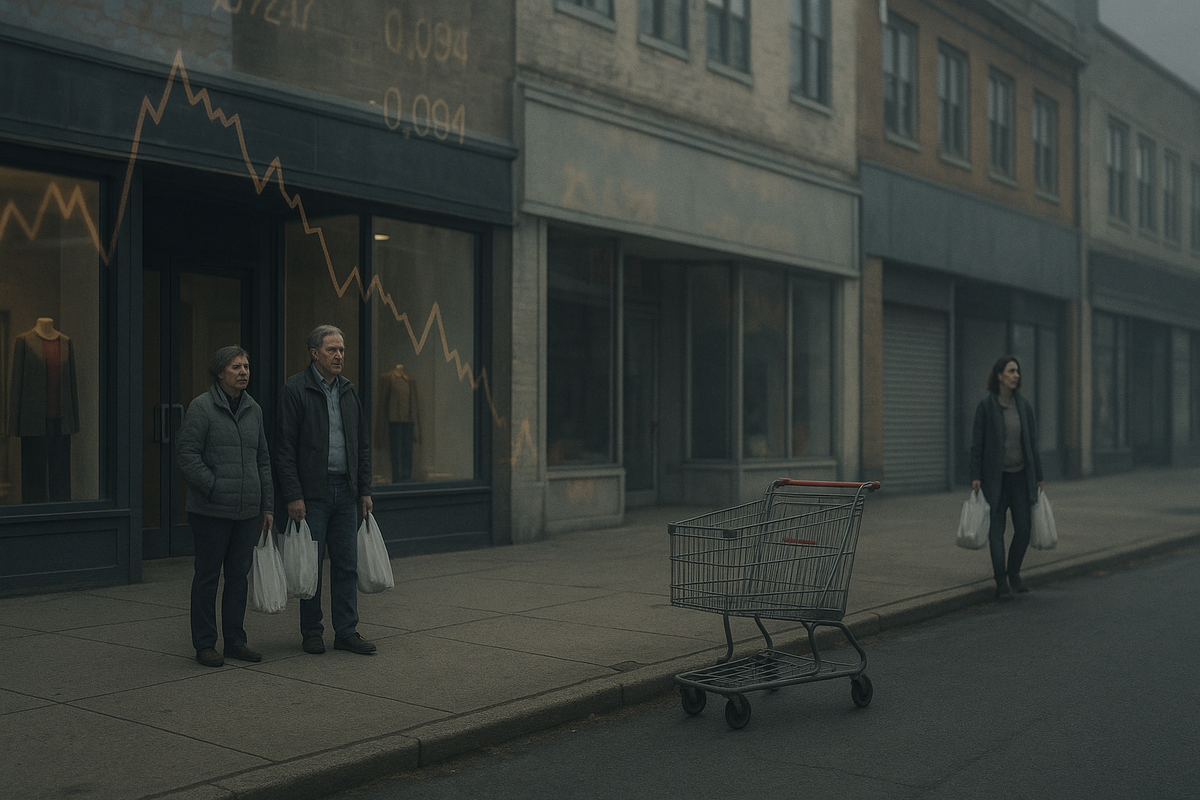
The bedrock of the U.S. economy, consumer spending, is showing concerning cracks, raising red flags for investors and economists alike. A confluence of a softening labor market and declining consumer confidence has put the stock market on edge, with upcoming retail earnings reports now serving as critical barometers for the nation's economic trajectory and the potential for a looming recession. As households tighten their belts amidst inflation worries and a less robust job environment, the immediate implications point to a deceleration in economic growth and increased volatility across various market sectors.
The Cracks Appear: Soft Labor and Shaken Confidence Signal Economic Headwinds
The narrative of a resilient economy is increasingly challenged by recent data, painting a picture of a consumer base under pressure. The U.S. labor market, long a pillar of strength, is exhibiting clear signs of cooling. In July 2025, the unemployment rate edged up to 4.2%, and job creation significantly missed expectations, with only 73,000 jobs added against a forecast of 115,000. Further reinforcing this trend, job figures for May and June were revised downwards by a combined 258,000 positions, suggesting a less vibrant hiring landscape than previously understood. Wage growth, while still positive, has decelerated, with the Indeed Wage Tracker showing annual growth slowing to 2.9% in June 2025. This, coupled with a dip in the labor force participation rate to 62.2% in July, indicates a tightening grip on the job market and reduced opportunities for many.
Simultaneously, consumer confidence has taken a notable hit, reflecting a palpable shift towards pessimism. The Conference Board Consumer Confidence Index slipped to 97.4 in August 2025, and more alarmingly, its Expectations Index fell to 74.8. This particular metric has now remained below the critical 80-point threshold—historically a harbinger of a recession within the next year—for seven consecutive months. The University of Michigan Consumer Sentiment Index also dropped to 58.6 in August, largely driven by escalating inflation worries, with year-ahead inflation expectations rising to 4.9%. This erosion of confidence is translating directly into behavior, with consumers expressing reduced intentions for discretionary spending on dining out, vacations, and big-ticket items, instead gravitating towards discount retailers and essential goods.
In this environment, retail earnings reports have become nothing short of economic report cards. These quarterly disclosures from major retailers like Walmart (NYSE: WMT), Target (NYSE: TGT), Home Depot (NYSE: HD), and Lowe's (NYSE: LOW) offer direct, real-time insights into how consumer spending is holding up against the backdrop of cooling job growth, persistent inflation, and the specter of tariffs. Investors meticulously scrutinize these reports for clues about purchasing patterns, shifts in consumer preferences, and any forward-looking guidance that might signal further cutbacks. The early 2025 retail sector earnings already indicated weaker revenue performance compared to previous periods, highlighting the vulnerability of the sector to the broader economic headwinds.
Navigating the Headwinds: Who Wins and Who Loses in a Cautious Economy
The shifting sands of consumer behavior create clear winners and losers across the corporate landscape. As consumers prioritize value and necessity, certain sectors and companies are better positioned to weather the storm, while others face significant headwinds.
The Potential Winners: In an environment where every dollar counts, discount retailers and purveyors of essential goods are likely to thrive. Companies like Walmart (NYSE: WMT) and Dollar General (NYSE: DG) stand to benefit as consumers "trade down" from more expensive options, seeking affordability in their everyday purchases. Supermarket chains and essential service providers are also relatively insulated, as demand for food, utilities, and basic necessities remains strong even during economic downturns. Additionally, companies offering services that are deemed essential or provide cost-saving alternatives, such as certain home repair services (for those delaying major renovations) or budget-friendly entertainment options, may see sustained demand. The rise of social commerce platforms catering to value-conscious shoppers also presents a growth avenue.
The Vulnerable Losers: Conversely, sectors heavily reliant on discretionary spending face significant challenges. Retailers specializing in high-end goods, luxury items, or non-essential consumer durables are particularly exposed. Companies such as Lululemon Athletica (NASDAQ: LULU) in athletic apparel or Restoration Hardware (NYSE: RH) in upscale home furnishings could see sales decline as consumers cut back on non-essential purchases. The automotive industry, including manufacturers like General Motors (NYSE: GM) and Ford Motor Company (NYSE: F), could also feel the pinch as higher interest rates and economic uncertainty make large-ticket purchases less appealing. Furthermore, the travel and hospitality sectors, encompassing airlines like Delta Air Lines (NYSE: DAL) and hotel chains like Marriott International (NASDAQ: MAR), may experience reduced demand for vacations and leisure travel as households prioritize saving over spending. Any company with high operating leverage and sensitivity to consumer sentiment is at risk in this evolving economic climate.
Broad Implications: A Wider Lens on Economic Recalibration
The current state of consumer health is not an isolated phenomenon but rather a critical piece of a broader economic recalibration, fitting into several overarching industry trends. The shift towards value and away from discretionary spending accelerates the pressure on traditional retail models, pushing more players towards e-commerce, discount formats, or a greater focus on private label brands. This trend also underscores the growing importance of supply chain resilience and cost management, as companies scramble to mitigate the impact of tariffs and inflationary pressures without alienating price-sensitive consumers.
The potential ripple effects are far-reaching. Suppliers to consumer discretionary companies, logistics providers handling non-essential goods, and even advertising agencies catering to luxury brands could face reduced demand. Furthermore, the persistent concerns about inflation and the softening labor market inevitably draw the attention of policymakers. While no immediate regulatory changes are on the horizon directly related to consumer spending habits, the Federal Reserve will be closely watching these indicators. Should inflation re-accelerate or consumer spending slow more sharply, the Fed might face difficult choices regarding interest rates, potentially leading to further hikes that would compound the economic slowdown. Historically, periods of sustained low consumer confidence and a weakening job market have often preceded economic contractions, though the exact timing and severity can vary. The current seven-month streak of the Conference Board's Expectations Index below 80 is a significant historical alarm bell, echoing similar patterns seen before past recessions.
What Comes Next: Navigating Uncertainty and Seeking Opportunity
The path forward for the U.S. economy and the stock market is fraught with both challenges and potential opportunities, depending on how these current trends evolve. In the short term, the market will be hyper-focused on the next round of retail earnings reports for concrete evidence of consumer resilience or further deterioration. Any signs of deeper spending cuts or pessimistic outlooks from major retailers could trigger further market corrections, particularly in consumer discretionary stocks. The upcoming jobs reports and inflation data will also be critical in shaping the Federal Reserve's policy decisions and, by extension, market sentiment.
In the long term, the economic landscape could see several strategic pivots. Businesses reliant on consumer spending may need to adapt by diversifying product offerings, enhancing value propositions, or exploring new markets. Companies that can innovate to reduce costs, improve supply chain efficiency, or provide essential services will be better positioned. From a market perspective, a prolonged period of cautious consumer spending could lead to a 'flight to quality' among investors, favoring companies with strong balance sheets, stable earnings, and defensive characteristics. Market opportunities may emerge in sectors that are traditionally resilient during downturns, such as utilities, healthcare, and consumer staples. However, the primary challenge remains the specter of a recession, which, if it materializes, would necessitate significant adaptations across almost all industries. Potential scenarios range from a "soft landing" where the economy merely slows without a full-blown recession, to a more severe downturn if inflation proves stubborn and consumer confidence erodes further, potentially prompting more aggressive monetary policy.
Conclusion: A Cautious Outlook Demands Vigilant Observation
In summary, the confluence of a softening labor market and rapidly declining consumer confidence presents a significant challenge to the U.S. economy and, by extension, the stock market. The recent data points, from dwindling job growth to pessimistic consumer sentiment indices, collectively underscore a growing caution among American households. This shift in consumer behavior, evidenced by reduced intentions for discretionary spending and a pivot towards value, will be sharply reflected in upcoming retail earnings reports, which serve as crucial real-time indicators of economic health.
Moving forward, the market is poised for increased volatility, with companies heavily reliant on consumer discretion likely to face continued pressure. Investors should anticipate a period of slower economic growth and closely monitor key economic indicators such as inflation rates, employment figures, and, most importantly, the forward guidance provided by retailers. The sustained warning signals from consumer confidence surveys suggest that while a recession is not an absolute certainty, its probability has undoubtedly increased. As such, a defensive posture, focusing on companies with robust fundamentals, strong balance sheets, and inelastic demand for their products or services, may prove prudent in the coming months. The ultimate trajectory of the market will hinge on whether consumers regain their footing or if the current hesitations solidify into a more prolonged economic retrenchment.





